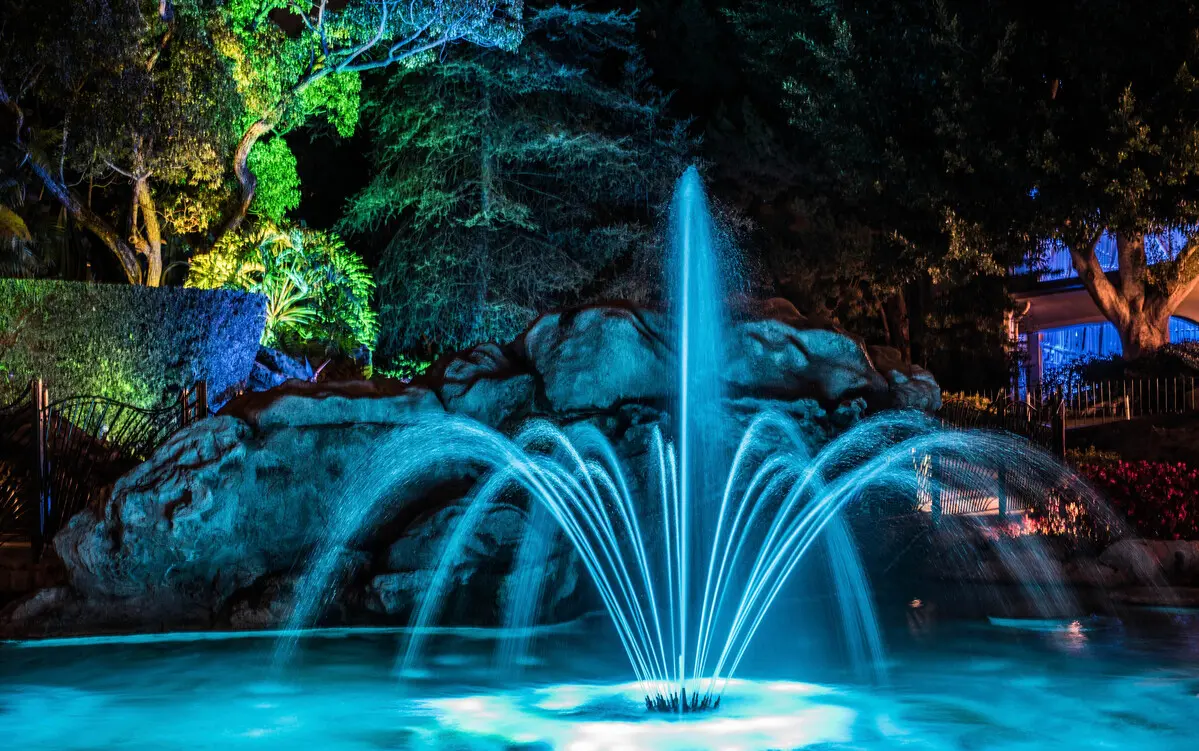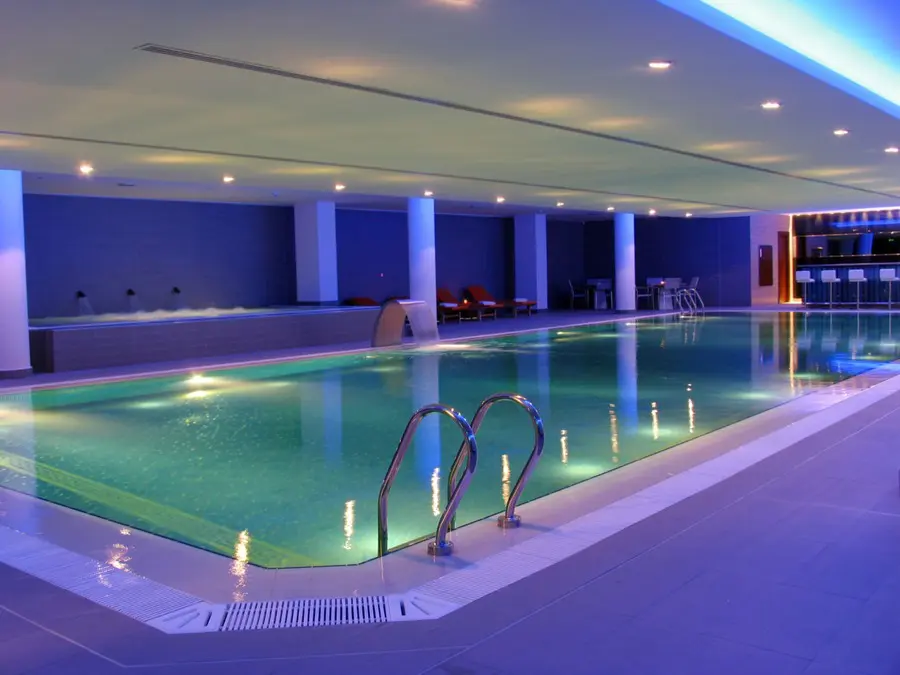The hospitality sector has always been extremely competitive, with new features and design ideas constantly appearing in order to entice new guests and visitors. This is why hotel and resort owners who have included fountains, wellness spaces and pools in their offering also need to look at ways to make their water features and overall space even more appealing.
When looking at enhancing the aesthetic appeal of your environment, lighting in hotels can bring a new and fresh perspective to your architecture and to its functionality.
In this article, we will cover:
- Aquatic features that boost hotels’ appeal and economic performance;
- How lighting can play a significant role in adding to this;
- How you can include LED lighting in your hotel and surroundings for maximum impact, efficiency and sustainability.
Dive deeper with the eBook
Hotel aquatic features
Increasing the functionality and the appeal of hotels with water features is a crucial and effective initiative. From adding to your commercial opportunities (as day guests can enjoy wellness centres or spas, in addition to overnight guests) to creating a more iconic image for the hotel, water installations are versatile and fit different spaces beautifully.
Furthermore, the right choice of water feature can also lead to better and easier maintenance, and to lowering running costs if the correct accessories are put in place.
Here are just some of the installations you can consider for your hotel:
- Indoor lap pools for sports activities;
- Outdoor multifunctional leisure pools for the whole family;
- Water shows or dry deck fountains at the entrance of the hotel;
- Ornamental water features including waterfalls, cascades, or water mirrors in indoor spaces;
- Ponds for gardens and green spaces;
- Wellness spaces with vitality pools, saunas, emotional/sensory showers, etc.
Besides, either to boost their appeal or for functional purposes, adding the best lighting options to these will further enhance the impact.
The role of lighting in hotels
Regardless of the type or size of the hotel or resort, lighting is key to defining its style, environment and warmth, both indoors and outdoors. This is why it needs to be thoughtfully integrated in the hotel’s architecture project overall.
Where to use lighting
Illumination systems in pools and fountains are a central element in guaranteeing an attractive atmosphere as well as safety in these aquatic installations, since they can actually help avoid accidental slips or falls that could result in injury.
For attractive solutions like dry deck fountains or water shows, the right type of lighting can really bring them out to guests at night. Specific colourful visual shows can then be added to reinforce the hotel’s brand image and to make the fountains into unique experiences for your guests.
Wellness spaces can find a powerful ally in lighting. It can strike a specific tone, create a relaxing atmosphere, and even align to users’ circadian rhythms for each wellness area or treatment. Additionally, the colour of lighting —the so-called chromotherapy — also has a potential effect on guests’ treatments.
The added importance of colour
Hotels seek a balance between technical and decorative lighting, where the latter complements the decorative style of the building. Indoors, you can create a warm atmosphere by using a combination of direct, indirect and side lighting. This will ensure a comfortable, welcoming environment for guests.
Of course, the colour of the lighting is also an important feature to be taken into account. Many hotels prefer the use of warmer, yellow tones over white lights, as these create cosier spaces. A good lighting can also enhance a hotel’s brand image by using common patterns and colors on its installations.
Lighting designs and their role
The lighting designs can also enhance specific architectural details, materials, surfaces or other visual stimulation. It’s not the same to design the lighting system for the outdoor facade, the common interior areas, restaurants or outdoor pool spaces. For example, the entrance hall needs to create an impressive reaction, while a cocktail bar or a wellness area will use a more relaxed and sophisticated lighting. Each area suits different tones.
Nowadays, lighting systems ensure hotels and resorts can generate themed ambiences, and extend their pools’ or fountains’ life by preparing them for night activities while remaining sustainable in terms of energy savings and cost-efficiency. Besides, all these attractive settings invite users to extend their visit, which may also turn into potential higher spend on adjacent business, such as bars and restaurants.
All in all, lighting can play a significant role in providing personalised experiences for hotel guests. Themed spaces offer immersive experiences that can match a hotel’s atmosphere and align with a business’ target audience. From designing lights that match specific water features or architectural aspects you wish to highlight, to using motion activated sensors to turn on lighting in dark spaces for safety, and everything in between, lighting can truly provide multiple lucrative opportunities in hotels.


Using LED lighting to enhance your hotel
Lighting makes up, on average, between 25 to 50% of the total energy consumption of a hotel or resort. Current lighting includes two options: halogen lamps (the conventional option) and LED lamps. Today, LED options are the most advisable in terms of environmental impact and energy consumption, while offering the same power and light quality as traditional systems.
Thus, it is crucial for hotel operators to find better solutions that guarantee energy savings and improve the efficiency of the lighting systems. LED lighting allows hotels to enhance the experience they offer, while also guaranteeing efficiency and sustainability of business’ installations.
The benefits of LED lighting include:
- Low consumption and high efficiency, compared to any other lighting systems;
- Long lifespan: the luminous flux maintains up to a 70% of intensity during 50,000 hours;
- Generating a well-balanced light and allowing the modification of photometric patterns using different lenses;
- Possibility of choosing between different colours and colour temperatures.
The area in which this LED lighting is going to be integrated is also an important aspect that must be taken into account in order to choose the ideal lamps. Here are some extra tips in this regard:
- For pools, it’s advisable to install one spotlight for every 20 square metres of water surface. This depends on the type of spotlight that is installed, as well as the type of pool basin materials;
- A maximum depth of 70 cm is recommended for spotlights, measured from the pool’s edge, in order to create an adequate lighting framework;
- In order to achieve a well-balanced lighting, it’s advisable to take into account that the more powerful the light beams, the more consistent and well-balanced the light will be.
Conclusion
Using lighting in hotels and resorts can enhance existing architectural features, bring out the magic of water shows, and draw attention to decorative elements such as waterfalls and cascades. Moreover, effective lighting will keep your guests safe by adding the right amount of visibility, especially in more relaxed and less well-lit spaces, where combining the atmosphere and safety is a challenge.
Finally, lighting can change the whole atmosphere of a room, making it warmer or colder, brighter and more active, or more subdued and relaxing. You have unlimited options and combinations at your disposal!
